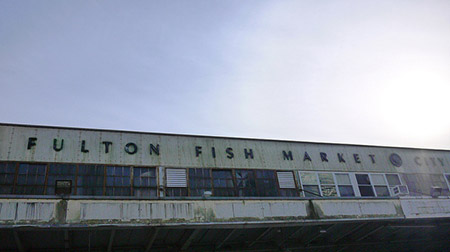Home of the old Fulton Fish Market. Creative Commons photo by Beau Unruh.
“I got a beautiful box over there, the best you ever seen, but you better hurry up. They don’t come any better than that, pal.”
So went a recent sales pitch to New York fishmonger Dan Feig, according to a piece last week in the New York Times.
It’s a fun read by Corey Kilgannon, who for years has a written a weekly column profiling interesting New Yorkers. This latest installment got me thinking about the Fulton Fish Market, where Feig does his buying, as it is now and as it used to be.
The 59-year-old Feig, according to the story, started working at the old Fulton Fish Market in Lower Manhattan when he was 17. In 2005, the market moved to Hunts Point in the Bronx, and is now known as the Fulton Fish Market Cooperative.
I remember when it moved, and I remember being aware, even then, that this marked another definitive endpoint in the the history of New York’s working waterfront. The original market opened in 1828.
It will tell you something about New York politics that the new market in the Bronx was first approved in 1969. An August 1974 article in the Times promised that work on the Bronx market would start in October of that year. Thirty-six years later, the fish sellers moved in.
In chronicling the market’s final days, the Times pulled out snippets of their old coverage, pointing out that opposition to the market — which occupied a short stretch of South Street alongside the East River — existed from the start:
“In 1854, a city elder wondered whether ‘a more advantageous disposition may not be made of that valuable property by the removal of the Fish Market.’ And in 1859, another sachem suggested moving the market uptown, in part because the ebb and flow of the East River was, as The New York Times delicately put it, ‘not sufficiently strong to carry off the offal.’”
It’s true, that part of town emitted a distinctive odor during market hours and long after, and the influence of organized crime became problematic. Law enforcement crackdowns solved the latter problem, but moving the market made sense for a lot of reasons. And by the time it actually moved, many workers were behind the plan.
 The Bronx home of the Fulton Fish Market. Creative Commons photo by Michael Cory.The Hunts Point space is clean, structured, and, perhaps most significantly, climate controlled. It maintains its traditional hours, opening at 1 a.m. and closing at 7 a.m., but not much else remains the same.
The Bronx home of the Fulton Fish Market. Creative Commons photo by Michael Cory.The Hunts Point space is clean, structured, and, perhaps most significantly, climate controlled. It maintains its traditional hours, opening at 1 a.m. and closing at 7 a.m., but not much else remains the same.
After touring the Bronx facility in 2005, then Mayor Michael R. Bloomberg was quoted as saying: "If you like crowded streets and unsanitary and dangerous conditions, you'll miss the old facility. Things change, the world changes, and we've got to keep up."
All true. But if you ever saw the old market in action, you saw old New York, and there’s not much of that left these days. People like Dan Feig — who called the new market 'paradise' — keep the attitude alive, but it would be impossible to recreate that same ambiance in a warehouse in the Bronx.
Dan Barry, writing about the final days at the old market, put it succinctly:
“More than the ghosts of characters, though, more than the whiff of the mob, there lingers in this city corner a palpable, connective air to who we once were; what we saw; what we said. The eels wriggling free along Fulton Street. The hook fights among fishmongers. The ice-coated masts of sloops in winter. The fedoras, the aprons, the scales of fish justice.”







